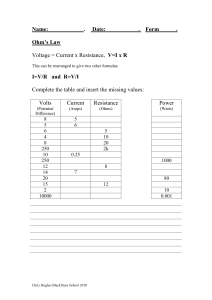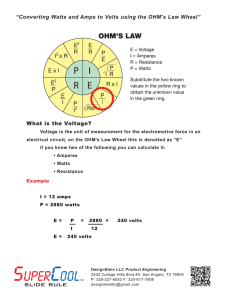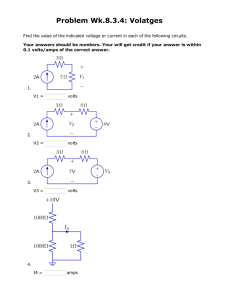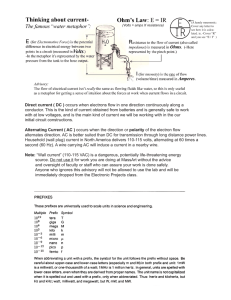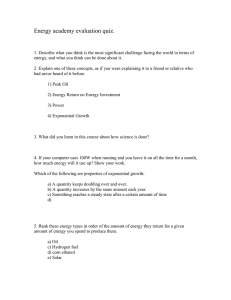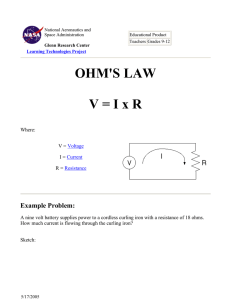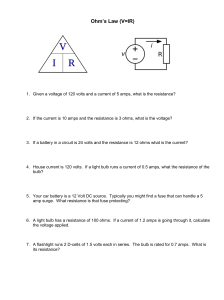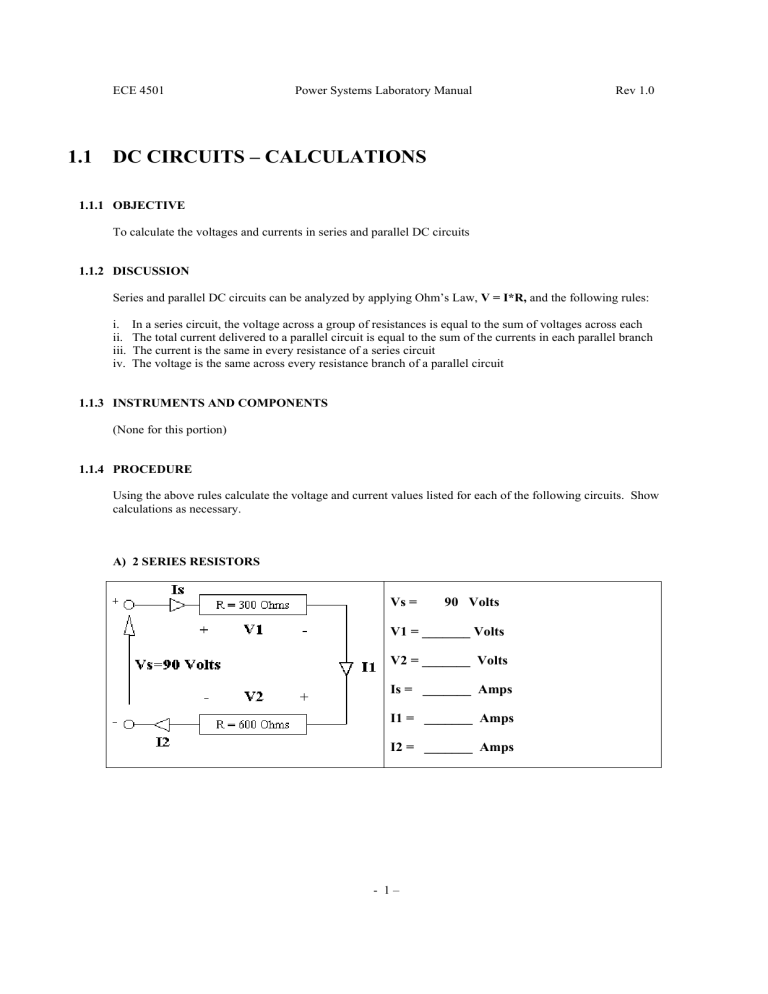
ECE 4501 Power Systems Laboratory Manual Rev 1.0 1.1 DC CIRCUITS – CALCULATIONS 1.1.1 OBJECTIVE To calculate the voltages and currents in series and parallel DC circuits 1.1.2 DISCUSSION Series and parallel DC circuits can be analyzed by applying Ohm’s Law, V = I*R, and the following rules: i. ii. iii. iv. In a series circuit, the voltage across a group of resistances is equal to the sum of voltages across each The total current delivered to a parallel circuit is equal to the sum of the currents in each parallel branch The current is the same in every resistance of a series circuit The voltage is the same across every resistance branch of a parallel circuit 1.1.3 INSTRUMENTS AND COMPONENTS (None for this portion) 1.1.4 PROCEDURE Using the above rules calculate the voltage and current values listed for each of the following circuits. Show calculations as necessary. A) 2 SERIES RESISTORS Vs = 90 Volts V1 = _______ Volts V2 = _______ Volts Is = _______ Amps I1 = _______ Amps I2 = _______ Amps - 1– ECE 4501 Power Systems Laboratory Manual Rev 1.0 B) 3 SERIES RESISTORS V2 = 30 Volts I2 = ______ Amps V3 = ______ Volts Vs = ______ Volts I1 = ______ Amps Is = ______ Amps V1 = ______ Volts C) 3 PARALLEL RESISTORS I1 = 0.2 Amps I2 = ______ Amps V1 = ______ Volts I3 = ______ Amps V2 = ______ Volts Is = ______ Amps V3 = ______ Volts Vs = ______ Volts D) COMPLEX CIRCUIT I3 = 0.2 Amps V1 = _____ Volts V3 = ______ Volts Vs = _____ Volts V2 = ______ Volts I2 = ______ Amps Is = ______ Amps - 2– ECE 4501 Power Systems Laboratory Manual Rev 1.0 1.1.5 CONCLUSIONS 1) If the power supply voltage in the first circuit (1.1.4 – A) were doubled, what would happen to the other voltages and currents in the circuit? ________________________________________________________________ ________________________________________________________________ ________________________________________________________________ If the polarity of the voltage in the first circuit was reversed, what would happen to the other voltages and polarities in the circuit? ________________________________________________________________ ________________________________________________________________ ________________________________________________________________ 1.2 DC CIRCUITS – MEASUREMENTS 1.2.1 OBJECTIVE To verify experimentally the theoretical calculations performed in Section 1.1 DC CIRCUITS – CALCULATIONS above. 1.2.2 DISCUSSION In circuits there are junction points (nodes) where wires meet and are joined together. According to Kirchoff’s Current Law (KCL) the sum of all currents at the node equals zero. In other words, the sum of all currents entering the node is equal to the sum of all currents exiting the node. The physical reason behind this is that energy cannot be stored in the node, so all electrons arriving at the junction must quickly leave. The following procedures attempt to verify KCL. 1.2.3 INSTRUMENTS AND COMPONENTS Power Supply Module (0-120 V-DC) Resistance Module DC Metering Module (200V, 500mA, 2.5A) Connection Leads DC Voltmeters and DC Ammeters EMS 8821 EMS 8311 EMS 8412 EMS 8941 -- - 3– ECE 4501 Power Systems Laboratory Manual Rev 1.0 1.2.4 PROCEDURE CAUTION! – High voltages are present in this Experiment. DO NOT make any connections with the power supply ON. Get in the habit of turning OFF the power supply after every measurement. The circuits for the following procedures are identical to those used in Section 1.1 DC CIRCUITS – CALCULATIONS above. For each circuit, perform each of the following: 1) Enter your CALCULATED values from section 1.1 in the spaces provided for each procedure. 2) Wire each circuit using the equipment listed in 1.2.3 above, being careful to observe the CORRECT metering polarities. The built-in voltmeter in the EMS 8821 unit will be used to measure supply voltage. Always make sure the supply switch is OFF and the output control knob is turned fully counterclockwise (0 Volts) when making connections. 3) Turn on the power supply and slowly turn the voltage control clockwise until the voltmeter on the DC power supply indicates the required voltage. 4) Take your measurements 5) Return the voltage to zero and turn off the supply. 6) Compare the calculated results with the experimental values. Indicate whether they agree or disagree. In the case of disagreement, try to determine the cause (“Stuff Happens” is an insufficient explanation). A) 2 SERIES RESISTORS Calculated Values Experimental Values Vs = Vs = _______ Volts 90 Volts V1 = _______ Volts V1 = _______ Volts V2 = _______ Volts V2 = _______ Volts Is = _______ Amps Is = _______ Amps I1 = _______ Amps I1 = _______ Amps I2 = _______ Amps I2 = _______ Amps REMARKS: _______________________________________________________ _______________________________________________________ - 4– ECE 4501 Power Systems Laboratory Manual Rev 1.0 B) 3 SERIES RESISTORS * Adjust Vs until V2 reads 30 Volts Calculated Values Experimental Values V2 = 30 Volts V2 = ______ Volts I2 = ______ Amps I2 = ______ Amps I1 = ______ Amps I1 = _NA__ Amps Is = ______ Amps Is = ______ Amps V1 = ______ Volts V1 = ______ Volts V3 = ______ Volts V3 = ______ Volts Vs = ______ Volts Vs = ______ Volts REMARKS: _______________________________________________________ _______________________________________________________ C) 3 PARALLEL RESISTORS Adjust Vs until I1 = 0.2 A Calculated Values Experimental Values I1 = Amps I1 = _______ Amps V1 = ______ Volts V1 = __NA___ Volts V2 = ______ Volts V2 = __NA___ Volts V3 = ______ Volts V3 = _______Volts Vs = ______ Volts Vs = _______Volts I2 = ______ Amps I2 = ______ Amps I3 = ______ Amps I3 = ______ Amps Is = ______ Amps Is = ______ Amps 0.2 REMARKS: _______________________________________________________ _______________________________________________________ - 5– ECE 4501 Power Systems Laboratory Manual Rev 1.0 D) COMPLEX CIRCUIT Adjust Vs until I3 = 0.2 A Calculated Values Experimental Values I3 = Amps I3 = ______ Amps V3 = ______ Volts V3 = ______ Volts V2 = ______ Volts V2 = _NA__ Volts I2 = ______ Amps I2 = ______ Amps Is = _______ Amps Is = _______ Amps V1 = ______ Volts V1 = ______ Volts Vs = ______ Volts Vs = ______ Volts 0.2 REMARKS: _______________________________________________________ _______________________________________________________ 1.2.5 CONCLUSIONS 1) Would an ammeter, such as those used in the experiment, burn out if connected to a circuit in such a manner as to reverse the polarity of the meter? _______________ Explain. ________________________________________________________________________ ________________________________________________________________________ ________________________________________________________________________ What about a voltmeter? _________ Why? ________________________________________________________________________ ________________________________________________________________________ 2) Could you measure the voltage of a flashlight cell using a DC Voltmeter with a scale of 0 to 150 Volts? _______________ Would such a measurement be useful? ________________________________________________________________________ ________________________________________________________________________ - 6– ECE 4501 1.3 Power Systems Laboratory Manual Rev 1.0 DC POWER – CALCULATIONS 1.3.1 OBJECTIVE To calculate the power dissipated in a direct current resistor and show that the power dissipated in a load is equal to the power supplied by the source (discounting any losses). 1.3.2 DISCUSSION The power source supplies electrical energy to a load where the energy is transformed into useful work. In the realm of electricity, useful work is denoted by the movement of electrons (electric current) at the load. POWER is the rate at which work is performed. An electromotive force of one volt producing one ampere of current through a one ohm resistance produces one watt of electric power. This relationship between voltage, current, resistance and power is summarized with the following equations: P = VI ; P = I2R ; P = V2/R (Watts) When electric energy is supplied to a resistor, that energy is immediately converted to heat energy, resulting in a physical rise in temperature of the resistor. The greater the amount of power supplied to the resistor, the greater the amount of heat generated in the resistor and thus the larger the rise in temperature. Since resistors are manufactured to meet a specific operating temperature at rated power and voltage levels, they are constructed to be physically large enough to dissipate the required heat energy. To avoid unacceptable temperatures, resistors that are required to dissipate significant amounts of electric power must be made with a large surface area. Increasing the physical size of a resistor improves both convection and radiation, the two primary means by which heat is dissipated. 1.3.3 INSTRUMENTS AND COMPONENTS (None) 1.3.4 PROCEDURE The circuits in this procedure are identical to those analyzed in Section 1.1 DC CIRCUITS – CALCULATIONS. 1) Enter the values calculated for each circuit in Section 1.1 in the spaces provided. 2) Use the power formulas given above to calculate power dissipation in each resistor in the circuit (P1 = V1 x I1, etc.). 3) Calculate the power delivered to the circuit by the supply (Ps = Vs x Is) and record the result. 4) Compare the power dissipated to the power supplied and remark upon any discrepancies. - 7– ECE 4501 Power Systems Laboratory Manual Rev 1.0 A) 2 SERIES RESISTORS Calculated Values Power Dissipated Vs = P1 = _______ Watts 90 Volts V1 = _______ Volts P2 = _______ Watts V2 = _______ Volts Ptot = _______ Watts Is = _______ Amps I1 = _______ Amps I2 = _______ Amps Power Supplied Ps = _______ Watts REMARKS: _______________________________________________________ _______________________________________________________ B) SERIES RESISTORS Calculated Values Power Dissipated V2 = 30 Volts P1 = _______ Watts I2 = ______ Amps P2 = _______ Watts I1 = ______ Amps P3 = _______ Watts Is = ______ Amps Ptot = _______ Watts V1 = ______ Volts V3 = ______ Volts Vs = ______ Volts Power Supplied Ps = _______ Watts REMARKS: _______________________________________________________ _______________________________________________________ - 8– ECE 4501 Power Systems Laboratory Manual Rev 1.0 C) 3 PARALLEL RESISTORS Calculated Values Power Dissipated I1 = Amps P1 = _______ Watts V1 = ______ Volts P2 = _______ Watts V2 = ______ Volts P3 = _______ Watts V3 = ______ Volts Ptot = _______ Watts 0.2 Vs = ______ Volts Power Supplied I2 = ______ Amps Ps = _______ Watts I3 = ______ Amps Is = ______ Amps REMARKS: _______________________________________________________ _______________________________________________________ D) COMPLEX CIRCUIT Calculated Values Power Dissipated I3 = Amps P1 = _______ Watts V3 = ______ Volts P2 = _______ Watts V2 = ______ Volts P3 = _______ Watts I2 = ______ Amps Ptot = _______ Watts 0.2 Is = _______ Amps V1 = ______ Volts Vs = ______ Volts Power Supplied Ps = _______ Watts REMARKS: _______________________________________________________ _______________________________________________________ - 9– ECE 4501 Power Systems Laboratory Manual Rev 1.0 1.3.5 CONCLUSIONS 1) Knowing that one watt of electric power is equivalent to 3.43 BTU/Hr (British Thermal Unit per Hour), calculate the BTU/Hr of heat dissipated by a hair dryer rated at 1500 Watts. _______________________________________________________________________________ _______________________________________________________________________________ 2) The circuit in C) 3 PARALLEL RESISTORS has 300, 600and 1200 Ohm resistors in parallel. If all three resistors were of the same physical size, which one would become hotter? Explain. _______________________________________________________________________________ _______________________________________________________________________________ 3) If both resistors in A) - TWO SERIES RESISTORS were of the same physical size, which would become hotter? Explain. _______________________________________________________________________________ _______________________________________________________________________________ 4) If three resistors, a 200, a 300, and a 600 ohm, were all designed to operate at the same temperature at a given voltage, which would be the largest physically? ______________ The smallest? __________ Explain. _______________________________________________________________________________ _______________________________________________________________________________ 5) A 100 watt incandescent lamp has a resistance when cold (de-energized) that is only 1/12 of its hot (energized) resistance value. What current does the lamp draw when energized by a 120 Vdc source (or 120 Vrms AC source)? What is the ‘hot’ resistance of the lamp? What is the ‘cold’ resistance? What current does the lamp draw at the instant after energization (i.e. while the resistance is still ‘cold’)? What power does the lamp dissipate at that instant? _______________________________________________________________________________ _______________________________________________________________________________ _______________________________________________________________________________ - 10 – ECE 4501 Power Systems Laboratory Manual Rev 1.0 1.4 DC POWER – MEASUREMENTS 1.4.1 OBJECTIVE To measure the power dissipated by resistors in DC networks and verify that the law of conservation of energy requires that the power dissipated by any number of resistive elements be equal to the power supplied by the source (when losses are neglected). 1.4.2 DISCUSSION As stated previously, power in a DC circuit is related to the applied voltage and resulting current by the following expression: Power, P = VI (watts) In a resistor, electric energy is converted to heat energy. The presence of heat energy creates a rise in the ambient temperature of the resistor and its surroundings. The rate at which the heat energy can be dissipated from the resistor to the surrounding environment is directly related to the physical size of the resistor. Converting electric energy to heat can be useful for many things, including the resistive heating elements in electric hot water heaters, electric ovens, etc. 1.4.3 INSTRUMENTS AND COMPONENTS Power Supply Module (0-120 V-DC) Resistance Module DC Metering Module (200V, 500mA, 2.5A) Connection Leads DC Voltmeters and DC Ammeters EMS 8821 EMS 8311 EMS 8412 EMS 8941 -- 1.4.4 PROCEDURE CAUTION! – High voltages are present in this Experiment. DO NOT make any connections with the power supply ON. Get in the habit of turning OFF the power supply after every measurement. 1) Remove the Resistance Module EMS 8311 from the Lab-Volt Station examine the 300, 600 and 1200 Ohm resistors inside 2) List the resistors in order of their heat dissipating capability (least to greatest): [Consider their physical size] __________________________________________________________________ 3) Which resistor can safely handle the most electric power? ___________________ - 11 – ECE 4501 Power Systems Laboratory Manual Rev 1.0 4) Connect the circuit shown below using the EMS Resistance, DC Metering and Power Supply Modules. Make sure the power supply is OFF before wiring. Take care to observe meter polarities. 5) Turn on the power supply and advance the voltage output until the voltmeter across the resistor, R, indicates 120 Volts, DC. Measure the current indicated by the ammeter. 6) Let the circuit operate for three minutes. In the meantime, calculate the power dissipated in the resistor. A) A SIMPLE DC CIRCUIT CALCULATIONS AND MEASUREMENTS Vr = 120 Volts Ir = _______ Amps Pr = Vr x Ir = ______ x ______ = _______ Watts 3.43 x Watts = __________ BTU/Hr 7) Return the voltage control to zero and turn OFF the power supply. Remove the resistance module from the console. Place your hand near the 300 Ohm resistor inside the module, but DO NOT TOUCH! The resistor should be quite warm since it is designed to operate at 350 C. Replace the module in the rack. 8) Calculate the BTU/Hr dissipated by the resistor: ____________________ BTU/Hr (1 watt = 3.43 BTU/Hr) 9) Change the value of the resistor to 600 Ohms and repeat steps 5)and 7) above. For 600 Ohms, Ir = _______ Amps 10) Return the voltage control to zero and turn off the supply. 11) Calculate the power dissipated in the 600 Ohm resistor by three methods: P = VI : _______ Volts x _______ Amps = ________ Watts P = I2R : _______ Amps2 x _______ Ohms = _______ Watts P = V2/R : ______ Volts2 / _______ Ohms = _______ Watts Do your results agree? _________ Explain: ________________________________________________________________________ - 12 – ECE 4501 Power Systems Laboratory Manual Rev 1.0 12) Connect the new circuit, B), shown below. Make sure the power supply is OFF. 13) Turn on the power supply and adjust the voltage control until the source voltage is 110 Volts, DC. 14) Measure and record the current and voltages. 15) Return the voltage control to zero and turn OFF the supply. B) A SERIES CIRCUIT Vs = 110 Volts Is = _______ Amps P1 = ______ Watts V1 = ______ Volts P2 = ______ Watts V2 = ______ Volts P3 = ______ Watts V3 = ______ Volts Ptot = P1+P2+P3 Ptot = ______ Watts Ps = Vs x Is = ______ Watts 16) Calculate the power dissipated in each resistor using the equation, P = VI. 17) Add the three powers and compare with the power supplied by the source, Ps = VsIs. Do the two values agree? ______________ 18) Could P1, P2, and P3 be determined without using the three voltmeters across the resistors? In other words, if the resistor values are known (and are accurate) and the source value is known, would the ammeter provide sufficient information to determine the power dissipated by each resistor? ______________ What equations would be used to calculate P1, P2, P3? _________________________________________________________________________________ 19) Connect the circuit, C), shown below, but DO NOT turn on the power supply at this time. - 13 – ECE 4501 Power Systems Laboratory Manual Rev 1.0 20) Using the input voltage of 90 Volts, DC, calculate the power dissipated by each resistor. Add them to determine the total power dissipated. 21) Knowing that the power supply must deliver all the dissipated power, determine the supply current, Is. C) A PARALLEL CIRCUIT Measurements Calculations Vs = 90 Volts P1 = (Vs)2/R1 = ______ W Vs = 90 Volts Is = _______ Amps P2 = (Vs)2/R2 = ______ W Ptot = P1 + P2 = ______ W Is = Ptot/Vs = ______ A 22) Turn on the power supply and adjust the voltage control until the supply voltage is 90 Volts, DC. Measure and record the ammeter reading for Is. 23) Return the voltage control to zero and turn OFF the supply. Does the measured value of Is agree with the calculated value? _____________ Explain: __________________________________________________________________________ __________________________________________________________________________ 1.4.5 CONCLUSIONS 1) Round copper wire, gauge 12 in size, has a resistance of 1.6 Ohms per thousand feet. Calculate the power lost in 200 feet of 12 gauge copper wire carrying 10 amps of DC current. Also, what is the voltage drop between the two ends of the wire? ________________________________________________________________________ ________________________________________________________________________ ________________________________________________________________________ - 14 – ECE 4501 Power Systems Laboratory Manual Rev 1.0 2) The shunt field winding of a DC motor has a resistance of 240 Ohms. Calculate the power loss in the winding when it is energized at 120 Vdc. ________________________________________________________________________ ________________________________________________________________________ ________________________________________________________________________ 3) A 1 amp fuse has a resistance of 0.2 Ohms. It will blow (melt) when the instantaneous value of current passing through it dissipates 5 watts of power inside it. What is the amp value of that instantaneous current? ________________________________________________________________________ ________________________________________________________________________ ________________________________________________________________________ 4) A ground rod at the base of a transmission line structure has a grounding resistance of 2 Ohms. If a lightning stroke of 20,000 amperes contacts the structure, what would be the power dissipated by the ground rod (and the earth it contacts)? Also, what is the voltage drop across the ground rod? ________________________________________________________________________ ________________________________________________________________________ ________________________________________________________________________ 5) Water Heater Example: One BTU is required to raise the temperature of one pound of water one degree Fahrenheit. How long would it take to heat 300 pounds of water (in a well insulated tank) from 60 F to 160 F using a 12 Ohm resistive element connected across 240 Volts? (one watt of electric power is equivalent to 3.43 BTU/Hr) ________________________________________________________________________ ________________________________________________________________________ ________________________________________________________________________ - 15 –
